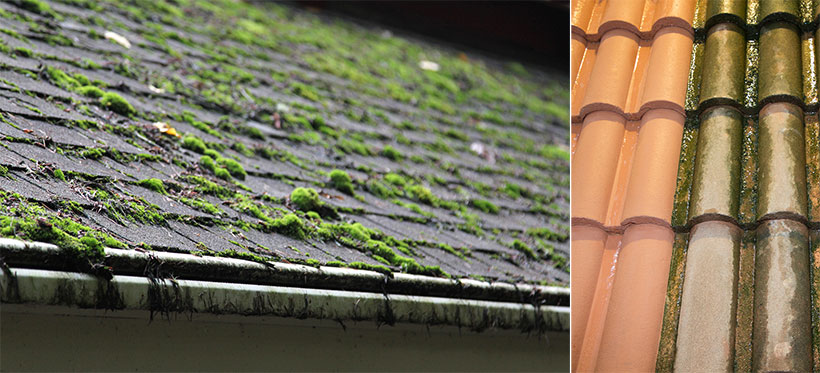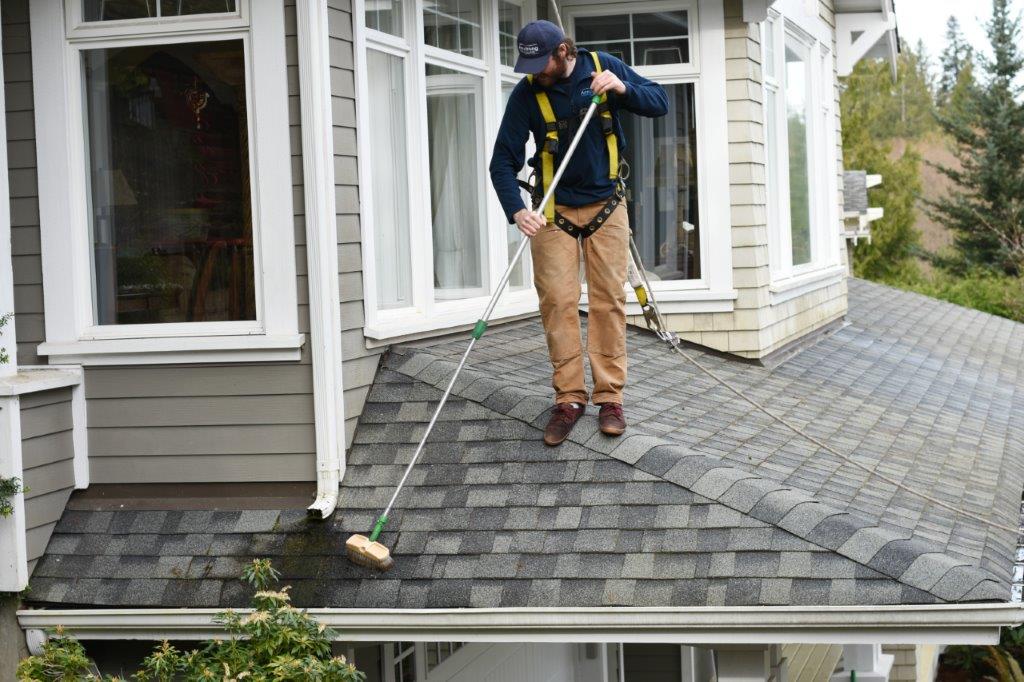Important Tips for Effective Moss Removal to Enhance Your Outside Area
Moss can be a consistent trouble in outside areas, frequently growing in damp and shaded locations. Understanding the underlying reasons of moss growth is important for effective elimination and prevention. Identifying the right methods and tools is necessary for tackling this issue. Furthermore, maintaining a healthy and balanced outdoor setting can significantly decrease the chances of moss returning. Exploring reliable strategies can transform neglected areas right into lively landscapes. What steps can one take to assure lasting outcomes?
Comprehending the Reasons For Moss Development
Although moss can add a stunning high quality to landscapes, its growth frequently shows underlying concerns in the environment. Usually, moss thrives in wet, shaded areas where sunshine is restricted, developing an optimal environment for its expansion. Poor drainage and compacted dirt add considerably to its spread, as these conditions retain wetness and inhibit proper water drainage. In addition, acidic dirt can prefer moss over preferred plants, resulting in discrepancies in the ecosystem. High humidity and regular rains better aggravate the issue, allowing moss to grow where other vegetation struggles. Lack of competitors from grass grasses can additionally assist in moss growth, specifically in overlooked areas. Generally, recognizing the root causes of moss growth is essential for effective management and elimination, guaranteeing that exterior spaces can go back to their intended visual and ecological feature. Resolving these underlying problems is vital to protect against future moss problems.
Identifying Locations Prone to Moss Build-up
Determining areas vulnerable to moss build-up is essential to effective monitoring and avoidance. Moss thrives in atmospheres that are wet, shaded, and have bad drain. Areas under trees or thick shrubs often experience low sunlight, creating suitable problems for moss development. Additionally, areas with compressed dirt, such as paths or heavily trafficked grass, may keep wetness, more promoting moss proliferation.
Moreover, inadequately draining surface areas like concrete or asphalt can additionally become moss hotspots, especially in shaded areas. Homeowners need to on a regular basis examine their exterior rooms, looking for signs of moss on roofing systems, patio areas, and yard beds. Determining these areas allows for aggressive procedures to be taken, such as improving sunshine direct exposure, improving water drainage, or changing landscaping. By recognizing these vulnerable areas, people can better plan for and avoid future moss concerns, ultimately resulting in a much healthier and much more aesthetically pleasing outdoor room.

Reliable Moss Elimination Methods
Removing moss successfully calls for a mix of strategies customized to the details surfaces and conditions where moss has held. For tough surfaces such as patio areas and driveways, a stress washing machine can be very efficient, blasting away moss without damaging the underlying product. When taking care of softer surface areas like roof coverings or wooden decks, a gentler approach is necessary; utilizing a soft-bristle brush and a mixture of vinegar and water can aid dislodge moss without triggering injury.

Preventing Future Moss Development
To stop future moss growth, it is necessary to improve sunlight exposure and boost water drainage systems. Boosting sunlight can hinder moss from thriving in shaded areas, while effective drain lessens moisture build-up. Executing these approaches can create a setting much less for moss expansion.
Boost Sunshine Direct Exposure
Exactly how can boosting sunshine direct exposure properly battle future moss development? By enabling a lot more sunshine to reach shaded locations, homeowners can considerably impede the ideal problems that moss prospers in. Moss normally embellishments in dark, wet environments; consequently, boosting light availability can interrupt its life cycle. Strategic tree trimming or removal might be required to boost sunshine in influenced locations. Furthermore, the use of reflective surface areas, such as light-colored stones or patio area materials, can additionally boost light penetration. Routinely checking and maintaining garden health additionally guarantees that sunlight can get to the ground properly. Implementing these steps not just minimizes the probability of moss regrowth but also promotes a healthier, extra vibrant exterior area.

Enhance Drain Equipments
Efficient water drainage systems play an essential function in preventing future moss growth in household landscapes. It creates a damp atmosphere conducive to moss expansion when water gathers in specific areas. To improve drainage, home owners must examine their landscape for low-lying areas and consider mounting French drains or swales to reroute excess water. Routine maintenance, such as getting rid of rain gutters and downspouts, will likewise advertise reliable water circulation. Furthermore, ensuring that soil is well-aerated can enhance absorption and lower water merging. Planting drought-resistant greenery can additionally reduce wetness retention, developing an unfavorable setting for moss. By attending to water drainage concerns proactively, homeowners can substantially minimize the likelihood of moss holding and preserve a see page much healthier, much more lively outside room.
Selecting the Right Products for Moss Control
When selecting products for moss control, home owners need to consider the advantages of all-natural versus chemical solutions. Each choice provides distinct benefits and prospective downsides, affecting performance and ecological effect. Additionally, understanding numerous application approaches can ensure optimal outcomes in moss removal initiatives.
Natural vs. Chemical Solutions
While both all-natural and chemical remedies offer practical choices for moss control, the choice often depends on specific preferences, ecological factors to consider, and the extent of the moss this content problem. Natural remedies, such as vinegar, baking soda, or salt, are commonly favored for their eco-friendliness and low toxicity. They can efficiently inhibit moss development without harming surrounding plants or dirt health and wellness. Alternatively, chemical solutions have a tendency to be much more powerful and can supply quicker results, making them ideal for serious infestations. Nevertheless, they might position dangers to non-target organisms and the setting if mistreated. Ultimately, the choice between all-natural and chemical items should reflect an equilibrium of efficiency, safety and security, and the overall influence on the exterior space.
Application Techniques Discussed
Choosing the best items for moss control entails comprehending the numerous application approaches available. Home owners can select in between granular, fluid, and foam products based upon their preferences and the certain location influenced by moss. Granular services are generally topped the moss-infested area, permitting gradual absorption and efficiency. Liquid therapies, typically applied with find a sprayer, deal instant insurance coverage and penetration, making them ideal for larger locations. Foam items offer targeted application, which can be beneficial for intricate surfaces like walls or roofings. Additionally, variables such as weather and surface area type must be thought about when selecting an approach. Eventually, comprehending these techniques allows reliable moss control, ensuring a healthier and much more attractive outside room.
Maintaining a Healthy And Balanced Outdoor Room After Elimination
After moss elimination, it is vital to apply effective maintenance strategies to guarantee the outdoor space stays healthy and dynamic. Routine grass care is very important; cutting at the proper height promotes grass wellness and prevents moss regrowth. In addition, ensuring ample sunshine reaches the grass and garden areas is important, as moss thrives in shaded settings.
Dirt wellness should additionally be focused on. Checking dirt pH and nutrient levels can direct appropriate changes, fostering a durable community. Proper drainage is another essential aspect; attending to any pooling water can prevent moss from reestablishing itself.

Frequently Asked Questions
Can Moss Be Beneficial for My Yard or Landscape?
Moss can be advantageous for gardens and landscapes by supplying ground cover, retaining dampness, and improving soil high quality. It additionally fosters biodiversity, supplying environment for little microorganisms and boosting the overall aesthetic appeal of outside spaces.
Exactly how Lengthy Does It Consider Moss to Grow Back After Removal?
Moss can grow back within a few weeks to several months after removal, depending upon ecological conditions like shade, soil, and wetness high quality. Normal upkeep is vital to protect against rapid reestablishment in impacted areas.
Is Moss Elimination Unsafe to Surrounding Plants or Wildlife?
Moss removal can potentially harm bordering plants and wildlife, particularly if chemical treatments are utilized. Hand-operated elimination, nonetheless, usually presents minimal threat, though treatment should be required to avoid troubling close-by plants and habitats during the procedure.
What Season Is Best for Moss Elimination?
The finest time for moss elimination is usually in early spring or late autumn. During these seasons, temperatures are moderate, and wetness degrees can aid facilitate the elimination process while decreasing anxiety on surrounding plants.
Exactly How Can I Inform if Moss Is Dead or Simply Dormant?
To establish if moss is dead or inactive, one should inspect its shade and texture. Healthy and balanced moss appears lively and eco-friendly, while dead moss tends to be brown and breakable, lacking wetness and elasticity.
Typically, moss grows in wet, shaded locations where sunshine is limited, developing an excellent habitat for its expansion. Getting rid of moss properly needs a combination of strategies tailored to the specific surfaces and problems where moss has taken hold. Increasing sunlight can hinder moss from thriving in shaded areas, while reliable drainage minimizes moisture build-up. By enabling much more sunshine to reach shaded locations, property owners can significantly hinder the perfect problems that moss prospers in. While both natural and chemical remedies provide practical alternatives for moss control, the choice typically depends on individual preferences, environmental factors to consider, and the severity of the moss trouble.